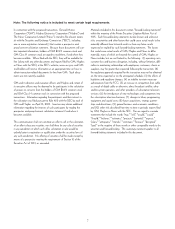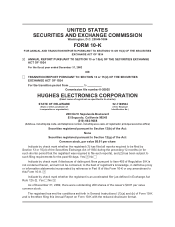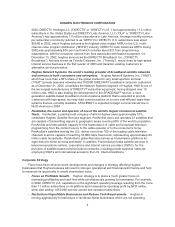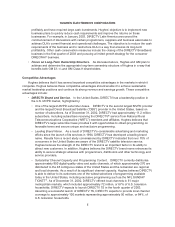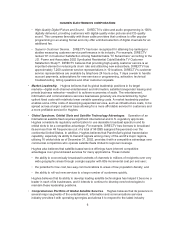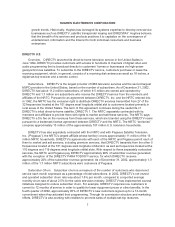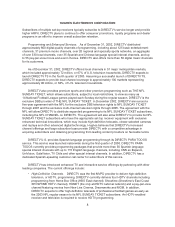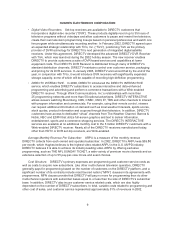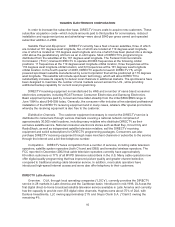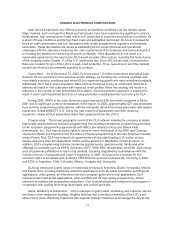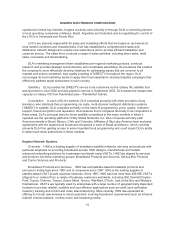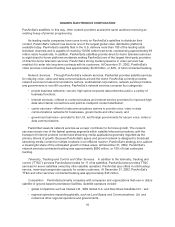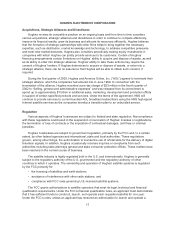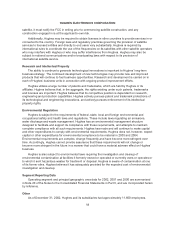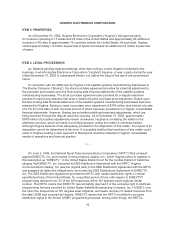DIRECTV 2002 Annual Report Download - page 19
Download and view the complete annual report
Please find page 19 of the 2002 DIRECTV annual report below. You can navigate through the pages in the report by either clicking on the pages listed below, or by using the keyword search tool below to find specific information within the annual report.HUGHES ELECTRONICS CORPORATION
•Digital Video Recorders. Set-top receivers are available to DIRECTV customers that
incorporate a digital video recorder (“DVR”). These products digitally record up to 35 hours of
television programs without videotape and allow customers to pause and rewind live television,
create their own television programming lineups based on personal preferences and watch one
live program while simultaneously recording another. In February 2002, DIRECTV agreed upon
an expanded strategic relationship with TiVo, Inc. (“TiVo”), positioning TiVo as the primary
provider of DVR technology for DIRECTV’s next generation of integrated digital satellite
receivers. Under this agreement, DIRECTV developed the advanced DIRECTV DVR Receiver
with TiVo, which was launched during the 2002 holiday season. The new receiver enables
DIRECTV to provide customers a suite of DVR-based services and capabilities at lower
equipment costs. The DIRECTV DVR Receiver is distributed through many of DIRECTV’s
standard distribution channels. DIRECTV maintains control over customer service, packaging
and pricing for its DVR services. In January 2003, DIRECTV announced that by the end of the
year, in conjunction with TiVo, it would introduce DVR receivers with significantly expanded
storage capacity, some of which will be capable of recording high-definition programming.
•DIRECTV INTERACTIVE. In 2000, DIRECTV introduced the DIRECTV INTERACTIVE
service, which enables DIRECTV subscribers to access interactive and data-enhanced
programming and advertising and perform e-commerce transactions with a Wink enabled
DIRECTV receiver. Through Wink Communications, Inc.’s relationships with more than
25 programming networks and more than 50 national advertisers, DIRECTV INTERACTIVE
allows viewers watching Bloomberg, CBS, CNBC, CNN, E!, TBS and other channels to interact
with program information and commercials. For example, using their remote control, viewers
can request additional information on demand such as local weather forecasts, sports scores,
stock quotes, product information and coupons through their television. In addition, DIRECTV
customers have access to dedicated “virtual” channels from The Weather Channel, Barnes &
Noble, NBC and ESPN that utilize full-screen graphics and text to deliver information,
entertainment, sports and e-commerce shopping services. The DIRECTV INTERACTIVE
services are available at no additional monthly cost to the 5 million DIRECTV customers with a
Wink-enabled DIRECTV receiver. Nearly all of the DIRECTV receivers manufactured today,
other than HDTV or DVR set-top receivers, are Wink-enabled.
Average Monthly Revenue Per Subscriber. ARPU is a measure of the monthly revenue
DIRECTV collects from each owned and operated subscriber. In 2002, DIRECTV’s ARPU was $59.80
per month, which Hughes believes is the highest video related ARPU in the U.S. MVPD industry.
DIRECTV believes it is able to achieve its industry-leading video ARPU by offering exclusive
programming, such as THE NFL SUNDAY TICKET, a wide variety of premium movie channels and an
extensive selection of up to 55 pay-per-view movie and event choices.
Cost Structure. DIRECTV’s primary expenses are programming and customer service costs as
well as costs to acquire new subscribers. Like other multi-channel television operators, DIRECTV
generally pays for programming based on the number of customers on the DIRECTV platform, and a
significant number of its contracts include most favored nation (“MFN”) clauses in its agreements with
programmers. MFN clauses provide that DIRECTV will pay no more for programming than do other
multi-channel operators with subscriber bases equal to or less than the size of DIRECTV’s subscriber
base. In addition, DIRECTV also incurs customer service related costs, which are also highly
dependent on the number of DIRECTV subscribers. In total, variable costs related to programming and
other cost of sales, and customer service represented approximately 51% of revenues in 2002.
9


